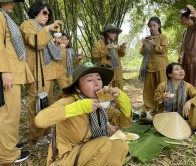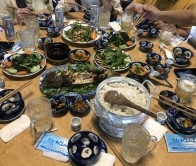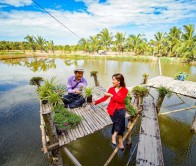Mekong Eco Tour-HISTORY OF CHAM PEOPLE
HISTORY OF CHAM PEOPLE
The Chams, or Cham people (Cham: Urang Campa,[5] Vietnamese: người Chăm or người Chàm, Khmer), are an ethnic group in Southeast Asia. They are concentrated between the Kampong Cham Province in Cambodia and Phan Rang–Tháp Chàm,Phan Thiết, Ho Chi Minh City and An Giang Province in Central Vietnam. Approximately 4,000 Chams also live in Thailand; many of whom have moved south to the Pattani, Narathiwat, Yala, and Songkhla Provinces for work. Cham form the core of the Muslimcommunities in both Cambodia and Vietnam.[6]
The Chams are remnants of the Champa polities (seventh to 18th centuries). They are closely related to other Austronesian peoplesand speak Cham, a Malayo-Polynesian language of the Austronesian language family‘s Chamic subgroup. This is in contrast to most of the neighbouring peoples, who speak Austroasiatic languages.
The ancestors of the Cham probably migrated from the island of Borneo.[7] Records of Champa go as far back as the second century. At its height in the ninth century, Champa controlled the lands between what is now modern Huế to the northern reaches of the Mekong Delta in southern Vietnam. Its prosperity came from maritime trade in sandalwood and slaves and probably included piracy.
Cham tradition claims that the founder of the Cham state was Lady Po Nagar. She originated from a peasant family in the mountains of Dai An, Khánh Hòa Province. Spirits assisted her when she sailed on a drift piece of sandalwood to China, where she married an heir to the royal family with whom she had two children, and then became Queen of Champa.[8]
The kingdom of Champa was an Indianised kingdom, but its people started to convert fromHinduism to Islam in the 11th century. This can be seen in the architecture of Cham temples, which shares similarities with the one of the Angkor Temples. Ad-Dimashqi writes in 1325, “the country of Champa… is inhabited by Muslims and idolaters. The Muslim religion came there during the time of Caliph Uthman… and Ali, many Muslims who were expelled by the Umayyads and byHajjaj, fled there”.[citation needed]
The Daoyi Zhilüe records that at Cham ports, Cham women were married by Chinese merchants to whom they frequently came back to after trading voyages.[9][10][11] A Chinese merchant fromQuanzhou, Wang Yuanmao, traded extensively with Champa and married a Cham princess.[12]
In the 12th century, the Cham fought a series of wars with the Khmer Empire to the west. In 1177, the Cham and their allies launched an attack from the lake Tonlé Sap and managed to sack the Khmer capital. In 1181, however, they were defeated by the Khmer KingJayavarman VII.









![Victoria Mekong Cruise – Ho Chi Minh City – Can Tho – Phnom Penh(5D/4N) [UPSTREAM 1]](https://mekongeco.com/images/thumbnail/268-445/1-2-2.jpg)
